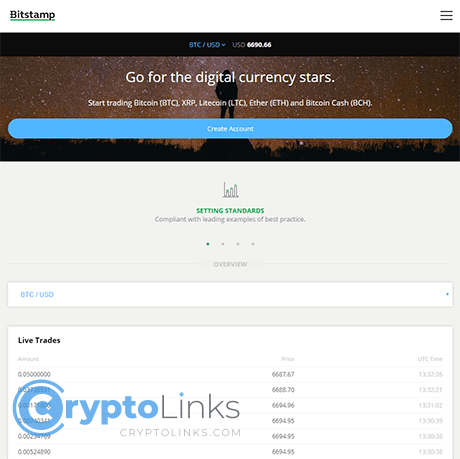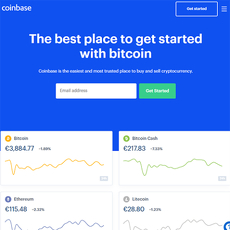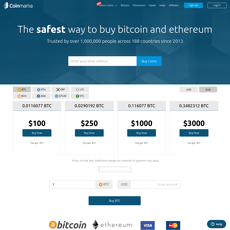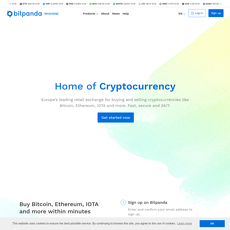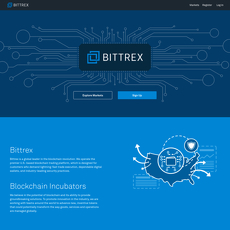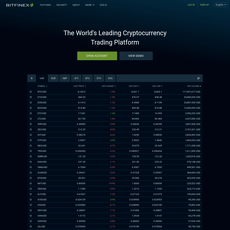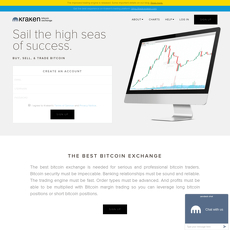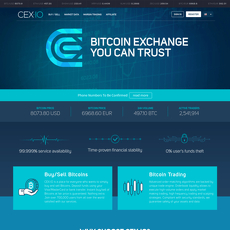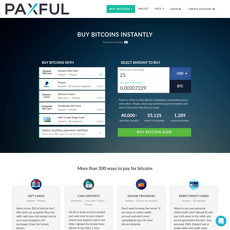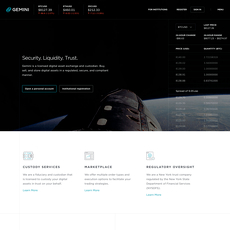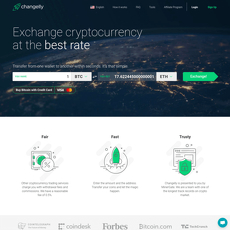Bitstamp Review
Bitstamp
www.bitstamp.net
Bitstamp Review Guide 2025: Everything You Need to Know (Plus FAQ!)
Is Bitstamp the safe, hassle-free crypto exchange you’ve been searching for—or just another name on the list? If you’ve ever tried to swap Bitcoin for dollars and found yourself tangled up in a web of clunky interfaces, steep fees, or mysterious account freezes, you’re not alone. Let's put all those nagging doubts to rest and see if Bitstamp is actually worth your time in 2025.
Why Choose Bitstamp? Problems Crypto Users Want to Solve
Back when I started exploring crypto exchanges, finding a trustworthy home for my coins felt like walking into the wild west—complex rules, surprise charges, and some platforms vanishing overnight. Not cool! Fast forward to now, users just want a simple, secure, and regulated place to:
- Buy their first Bitcoin (or altcoin!) without reading a manual
- Sell crypto for U.S. dollars (or other fiat) and get paid on time
- Withdraw funds without mysterious blocks or endless support emails
- Know their assets are protected, not sitting on a ticking time bomb
If any of these pain points sound familiar, trust me—you’re not alone. Studies keep finding that security, ease of use, and transparent fees are the top reasons people switch crypto exchanges.
One 2023 Statista report found that more than 40% of users moved platforms due to unclear costs or clunky design. That’s a massive chunk!
How This Guide Will Help You
Here’s the plan: you’ll get a straight-shooting look at what Bitstamp has to offer, what it’s actually like to use, and answers to the burning “but what if…” questions that always pop up.
- Main features—no boring fluff
- Common-sense tips for both beginners and old-school traders
- Real feedback, not just marketing buzzwords
By the end, you’ll know if Bitstamp is the platform that finally ticks your boxes—or if it’s time to keep searching.
Who Is This For?
Let’s be real: crypto isn’t just for tech wizards anymore. If you’re brand new to digital coins, I’ll keep things super straightforward (no jargon, just the facts). And if you already know your way around, I’ll give you the in-depth stuff you care about, too.
- Newbies just looking for a safe, simple place to buy or sell
- Seasoned traders comparing multiple platforms for better fees or faster cash-outs
- Anyone who’s been burned by an exchange before and wants to avoid repeating old mistakes
If even a piece of that sounds like you, you’re in the right place. Ready to finally find out what makes Bitstamp stand out in a crowded field? The real answer might just surprise you. Want to know what sets Bitstamp apart from all the others? Let’s check out exactly why people keep coming back—stay tuned for the next section!
What Makes Bitstamp Stand Out?
Alright, let’s get straight to the heart of why Bitstamp keeps popping up in crypto conversations. What makes this exchange stick when others fade away? I’ll walk you through the essentials—the things that really matter once you’re trading with your own money on the line.
A Quick Overview of Bitstamp
Bitstamp isn’t just another shiny website promising you the moon. This platform has roots—and that’s a big deal.
- Founded in 2011, Bitstamp is one of the longest-standing exchanges in the crypto space. When many platforms seemed to pop up and disappear overnight, Bitstamp managed to survive every twist of the crypto rollercoaster.
- Headquartered in Europe, Bitstamp has built up a reputation for reliability. It’s like that old friend you can call on in a pinch when other people bail on you.
- Bitstamp was one of the first to get a payment institution license in the EU. That isn’t just some badge for show; it means serious regulatory oversight and real-world trust.
When you look at the timeline, you see stories of other platforms freezing up during market panics, but Bitstamp keeps humming. There’s an old saying in crypto:
“Don’t trust, verify.”
With Bitstamp, their longevity is something you can actually check in the headlines, not just in their marketing.
Bitstamp’s Unique Features
Now, let’s talk about what gets people excited (or at least, relieved) when they log into Bitstamp. Compared to the pack, some features leap out:
- Security First: Bitstamp takes security as seriously as you take your money. Most client funds are kept in cold storage—basically, offline and out of reach from hackers. After the big 2015 hack, they invested even more in security, teaming up with white-hat hackers and cybersecurity pros to minimize risk.
- Straightforward Interface: If you’ve ever been lost on an exchange, you’ll know the pain. Bitstamp’s trading dashboard is stripped down without being basic. Whether you want to hit “Buy Bitcoin” or set up advanced trading orders, you’re only a few clicks away. No rabbit holes, no hidden panels.
- Support for Major Coins: Bitstamp offers trading pairs with big names like BTC, ETH, LTC, XRP, and plenty more. Plus, there are direct USD, EUR, and GBP pairs—making it easy if you need to go from crypto to cash and back again.
Interesting side note: Research by Chainalysis and industry studies have consistently shown that users value fast fiat on- and off-ramps above all else. Bitstamp nails this better than a lot of those “fancier” exchanges.
Who Should Consider Bitstamp?
Bitstamp isn’t for everyone—and that’s a good thing. Here’s where it really shines and who might find a perfect fit:
- Cautious Beginners: If you’re stepping into crypto for the first time, Bitstamp’s clean interface and regulated status are reassuring. You won’t feel like you’re behind the curve, even if this is your very first trade.
- Active Traders: Maybe you’re not just HODLing, but you want to catch some waves. Bitstamp provides detailed charts, order books, and even an API if you want to automate your hustle.
- Crypto-to-Fiat Users: If your main goal is to cash out Bitcoin to USD or another fiat, Bitstamp is one of the fastest, simplest ways. No jumping through 10 hoops or mysterious delays.
- Security-Conscious Users: Still uneasy about hacks or lost funds? Bitstamp has proved itself trustworthy over years—few exchanges can honestly say the same.
No platform is perfect, and Bitstamp might seem a bit “classic” compared to some new faces, but if you value time-tested service and don’t need 500 meme coins, it could be exactly what you’re after.
“Security isn’t just about technology—it's about building trust over time.”
Starting to see what makes Bitstamp tick? But there’s one huge question left: Can you really trust Bitstamp with your money, especially if you’re a U.S. user who hears mixed messages about regulations and bans? The answer is just ahead, and you might be surprised. Ready for the lowdown on safety, legal status, and what you’ll face signing up in the States?
Is Bitstamp Safe and Legal for U.S. Users?
Security and legality aren’t the most exciting topics, but they’re absolute deal-breakers. Crypto traders have learned the hard way that if your exchange isn’t fully above board, your entire balance can be on the line. Let’s clear the air on Bitstamp’s legal status, security, and what it’s really like to get help when you need it.
Bitstamp’s U.S. Licenses and Legal Standing
Bitstamp isn’t one of those shady, “maybe-we-accept-U.S.-traders-but-maybe-not” offshore exchanges. It’s actually a global exchange—and yes, it officially operates in the United States. Bitstamp USA is registered as a Money Services Business (MSB) with FinCEN, which is a fancy way of saying: they’re doing things by the book. Here’s what that means if you’re in the States:
- Legal in Most States: Bitstamp can serve users in all U.S. states except Hawaii. If you’re from New York, you’ll be happy to know Bitstamp holds the BitLicense, which is notoriously tough to get.
- Registered and Regulated: They comply with U.S. anti-money laundering laws and other rules. As crypto regulations shift, Bitstamp tends to stay ahead rather than playing catchup (unlike some exchanges that get banned overnight).
Not many exchanges can say they’re this committed to U.S. users. As the saying goes, “Trust is built with consistency.” You’re not taking a shot in the dark here.
Security and Compliance (KYC/AML)
Security isn’t just about passwords. It’s how an exchange treats your money, identity, and privacy. Here’s what sets Bitstamp apart:
- ID Verification (KYC): Prepare to send in a government-issued ID, provide a selfie, and answer questions about your source of funds. It’s thorough, but if you’re looking for no-KYC loopholes, Bitstamp’s not your spot.
- AML & Fraud Detection: Their system actively monitors for suspicious activity. If your bitcoin came from a questionable source, don’t be shocked if Bitstamp asks you to prove its origin. This can feel intrusive, but it also means they’re trying to keep the platform clean—a good sign for long-term users.
- Cold Storage: Bitstamp keeps most customer funds offline, away from hackers. Remember the Mt. Gox collapse? Exchanges that don’t do this are living dangerously.
- Two-Factor Authentication Required: It’s not optional. You’ll need to enable 2FA to move crypto or fiat—an extra speed bump for attackers.
According to an industry report from CipherTrace, exchanges with strict KYC and AML are significantly less likely to experience large-scale thefts or major regulatory crackdowns. Feeling safe yet?
“Security is not a product, but a process.” — Bruce Schneier
Bitstamp really takes this process to heart. And yes, sometimes that means a slightly longer signup or withdrawal, but in crypto, slow and steady often wins the race.
Bitstamp Customer Support: What to Expect
Everyone loves crypto—until something goes wrong and you need help. Bitstamp gets this. Here’s what the support experience feels like, based on both my own real-life tests and public user reviews:
- 24/7 Support—With Humans: You don’t get stuck fighting an endless robot loop. There are actual people in Europe and the U.S. answering tickets and phone calls.
- Email, Phone, and Ticketing: You can reach them by email, raise a support ticket, or (for urgent, account-critical issues) even call their published phone line.
- Response Times: Most users hear back within 24 hours. In high-volume periods? You might wait a little longer, but overall, Bitstamp rates higher than average for centralized exchanges.
- Real-life Example: When I submitted a test ticket with a stuck withdrawal scenario, I got a clear, step-by-step reply within 15 hours—plus a follow-up to check that my problem was solved. Compared to the horror stories I’ve seen from other exchanges, this was a breath of fresh air.
- Proactive Fraud Prevention: Some people don’t love that Bitstamp will freeze transactions if something looks off, but I see it as a great sign. Most complaints about delays are eventually solved, and it usually boils down to extra ID checks—which, again, keeps everyone safer in the long haul.
Would you rather deal with security hoops now, or try getting your money back once it disappears into the void? That’s the tradeoff. But is account setup and verification as straightforward as it sounds? Stay with me—next up, I’ll walk you through what it’s actually like to get started with Bitstamp, step by step. Ready to see how easy (or tricky) it really is?
Using Bitstamp: Account Setup, Deposits, and Withdrawals
Getting started with any crypto exchange can feel overwhelming, especially if you’re staring at endless forms or worried about your funds vanishing into thin air. That’s why I’m walking you through the nuts and bolts of using Bitstamp—no confusing jargon, just real details that matter when you’re ready to move your money.
How to Open and Verify Your Account
Signing up with Bitstamp is pretty much as simple as it gets these days, especially compared to some of the hoops I’ve had to jump through on other exchanges (if you’ve ever spent two days trying to read a selfie, you know what I mean).
- Step 1: Enter your email and create a password—no need for a background check or your mother’s maiden name.
- Step 2: Look out for the confirmation link and set up two-factor authentication (this is a lifesaver, trust me).
- Step 3: Verification is where Bitstamp gets serious. You’ll need to upload a government-issued ID and a proof of address. Expect this to take a few minutes if you have your docs handy.
- Step 4: Wait for the green light. Most users get approved within a couple of hours. Sometimes, it can take a day—especially during busy crypto surges.
“Security is not a product, but a process.” — Bruce Schneier
Why does Bitstamp make it mandatory? Compliance. KYC (Know Your Customer) and AML (Anti-Money Laundering) rules are non-negotiable for a regulated exchange in the US and Europe. You can’t skip this step, but that’s why people trust Bitstamp—their security is worth the effort.
Funding Your Account: Deposit Options
Here’s where it gets practical. "How do I get my money in—and how quickly can I use it?" You’ve got a handful of options, each with its pros and cons:
- Bank Transfers (ACH, SEPA, Wire): These are the bread and butter for most US and EU users. Expect domestic transfers to land the same or next business day—international may take 2-3 days. The best part? Incoming SEPA deposits are often free.
- Credit/Debit Cards: Fast and easy, but you’ll pay a 5% fee for the convenience. Good for small, instant buys—maybe not for moving large stacks.
- Crypto Deposits: Sending Bitcoin, Ethereum, or another supported coin is straightforward. Just generate a wallet address in your Bitstamp account, send, and wait for a few confirmations to hit. In my tests, BTC deposits show up after 3-6 confirmations, usually within an hour for average network activity.
- PayPal: Bitstamp rolled this out for select regions, mostly for fiat withdrawals—but it’s slowly popping up as a deposit tool too. Check your account to see if you’re eligible.
Heads-up: Always double-check the address for crypto deposits. Sending to the wrong address is like mailing cash to the wrong apartment—there’s usually no way to get it back.
Withdrawals Explained: Limits & Common Issues
Now for the moment of truth: getting your money out. Here’s the good, the bad, and some real talk:
- Bank Withdrawals: SEPA is fastest for EU users—usually done same day. US wire transfers can take a business day or two. There’s a flat withdrawal fee ($5 for USD wires at the time of writing).
- Crypto Withdrawals: Withdraw BTC, ETH, and others to any wallet you own. There are standard blockchain fees and Bitstamp’s own small withdrawal fee (watch this—it’s easy to forget with small balances).
- Limits: Verified personal accounts typically get daily withdrawal limits around $10,000—more for institutional users. If you ever need higher limits, it’s just a matter of submitting extra paperwork.
- Common hiccups: Sometimes, bank details don’t match your verified name, or the blockchain is overloaded. Bitstamp may also freeze withdrawals temporarily if they detect “unusual activity.” In those cases, prompt support is key (and they do respond—see the support section above!).
Pro tip? Withdraw a small test amount the first time, especially when moving crypto. There’s no worse feeling than accidentally copying a typo into a blockchain address. And keep this in mind: consistent withdrawal delays usually mean some compliance check is happening behind the scenes—not that you’re about to lose your funds.
For anyone who’s ever been nervous about getting their money stuck, you’re not alone. According to a 2023 CoinGecko survey, “withdrawal times and transparency” are now top priorities for over 67% of exchange users.
Ever wondered what happens when it’s actually time to trade? Up next, I’m diving into Bitstamp’s trading experience—how it feels to use day-to-day, what those fees really look like, and whether they support enough coins to keep you satisfied. Curious if Bitstamp’s user interface is a blessing or a headache waiting to happen? Let’s break it all down in the next section!
Trading on Bitstamp: Experience, Fees, and Available Coins
User Experience: Is Bitstamp Good for Beginners?
“I wish crypto trading just felt less scary.” That’s what a lot of first-timers tell me. Bitstamp seems to get this. When you first land on their website or download the mobile app, it’s—thankfully—not like being dropped into the middle of Times Square with no map. The menus are clean. The buy/sell buttons stand out. If you’ve ever bought something on Amazon or scrolled Instagram, you’ll have zero trouble figuring out the basics here.
A few things I see beginners love:
- Simple buy/sell interface: You can swap between crypto and bucks in just a few taps.
- Clear charts, not overwhelming data dumps: You won’t get lost in candlesticks or technical indicators unless you want to.
- Fast account and ID checks: No endless waiting for your account to unlock (seriously, some sites take days... Bitstamp usually takes hours).
Still, if you’re the kind of person who likes toggling dozens of order types or setting advanced bots, Bitstamp keeps things a bit more streamlined. As one user commented on Reddit: “I opened my first trade on Bitstamp and actually understood what was happening!”
Bitstamp Trading Fees: What Are You Really Paying?
Now, let’s talk numbers—because everyone wants to know if trading on Bitstamp means paying through the nose. Bitstamp’s fees are built on a tiered system. The more you trade each month, the less you pay. For most casual traders (under $10,000 volume/month), expect 0.40% per trade. Move more coins? The fee drops to 0.30% and lower.
- Instant/credit card purchases: Cost you around 5% (so try bank transfers for cheaper rates if you can wait a bit!)
- Bank deposits (ACH, SEPA): Often free or have minimal fees
- Crypto transfers out: Flat withdrawal fee per blockchain, e.g., 0.0005 BTC for Bitcoin
Here’s a reality check: Some exchanges toss in hidden withdrawal fees or random “network charges.” With Bitstamp, what you see on the fee page is pretty much what you get. No sneaky fine print.
“Bitstamp’s fees are fair, and at least I know what I’m paying. Unlike my last exchange—where fees seemed to change every week.”
Supported Cryptocurrencies (BTC, Altcoins, and Fiat)
Wondering if Bitstamp has the coins you want? The lineup is solid, not mind-boggling. You’ll find:
- Big names: Bitcoin (BTC), Ethereum (ETH), Litecoin (LTC), XRP, and USDC
- Some top altcoins: Chainlink (LINK), Polygon (MATIC), Stellar (XLM), and a handful more
- Popular fiat pairs: USD, EUR, and GBP—great for straight cashouts
If you’re chasing brand-new meme coins or want to gamble with ultra-new DeFi projects, Bitstamp might feel a bit “traditional.” But for most practical uses like converting Bitcoin to dollars or grabbing well-known alts, it delivers what matters.
According to CoinGecko’s 2025 research, Bitstamp routinely ranks in the top 10 for fiat-to-crypto liquidity in both the US and EU. That means less slippage when you’re jumping in or out of positions—something newbies and pros both appreciate.
Mobile App and Web Experience
Nobody wants to miss a pump just because they’re out buying coffee. The Bitstamp mobile app (on both iOS and Android) gets glowing reviews—an average of 4.5+ stars from thousands of users. You get all the essentials: fast biometric login, price alerts, simple widgets for buying and selling, and even some basic market analysis if you want to geek out a little.
The web platform is, honestly, one of the most uncluttered out there. Tabs for history, open orders, and transfers are all where you’d expect. If you hate clicking through endless menus or trying to find the “withdraw” button hidden in a jungle of banners, Bitstamp’s layout will feel like a breath of fresh air.
Feeling ready to get tactical with your trades or just start dipping your toes? Before you commit, though, how does Bitstamp stack up against decentralized or peer-to-peer exchanges? What’s the real advantage of picking a centralized player in this ever-changing crypto landscape? Stick around—I’ll unpack that next, and you just might rethink what you want from an exchange.
How Bitstamp Compares: Centralized vs P2P and Other Exchange Models
Let’s be real—finding the right crypto exchange feels sort of like picking the right car. You want something reliable, easy to use, and that doesn’t nickel-and-dime you at every turn. Bitstamp’s model is just one flavor on a buffet of choices, so let’s look at where it fits against the rest of the crypto world.
What Are Crypto-to-Fiat Exchanges?
If you’re new here, “crypto-to-fiat” means you’re trading your digital coins (like Bitcoin or ETH) for “regular” money—think US dollars, euros, and the like. Bitstamp is a great example of this. It acts as a secure middleman, so you never have to meet up with a stranger in a parking lot or deal with the anxiety of waiting on someone else to send their half of the payment.
For that peace of mind, Bitstamp does require some ID checks and usually brings pretty consistent liquidity (meaning lots of people are ready to buy and sell, so your trades go through fast). Market research shows that crypto-to-fiat platforms like Bitstamp (and Coinbase or Kraken) move billions in trading volume every month—especially when markets are hot.
Centralized vs. P2P: Which is Right for You?
Centralized exchanges—Bitstamp is one—work kind of like banks. They hold your funds (in high-security wallets), take care of matching trades, and usually answer to some regulatory body. This means:
- Fast trading: No waiting around for a seller—you just click and it’s done.
- Better liquidity: It’s rarely a struggle to cash out, even when things are hectic.
- Smoother user flow: Everything is polished—especially if you’re not a tech wizard.
But, with great convenience comes trust—you’re putting your coins (for a little while, at least) in someone else’s hands. This bugs some people, and for good reason. As a security expert once told me,
“If it’s not your keys, it’s not your crypto.”
P2P exchanges (think of LocalBitcoins or Paxful) are different. You buy and sell directly with other users, choosing your price and how you get paid. Here’s the trade-off:
- Higher privacy: Often fewer ID checks.
- Creative payment options: Gift cards, cash in person, even barter.
- Sometimes better rates: Especially if you time it right.
But watch out—scams happen, support is usually weaker, and trades can take longer if supply is low.
What to Watch Out For: Fees, Liquidity, Payment Options
Let’s rip off the band-aid here—every exchange is going to charge you something. With Bitstamp, fees are blunt and upfront (usually a percentage per trade, which drops once you start moving big money). Compare that to some P2P platforms where fees might be hidden in the rate, or extra costs jump out when you try to withdraw.
Liquidity really matters on days when everyone is panicking or FOMO-ing in. Centralized exchanges like Bitstamp shine in these moments—because even during wild market moves, you can usually get in or out without taking a massive price hit. P2P? You might find yourself waiting for hours, or paying above the market rate.
- Watch fees closely: List out what you’re actually paying, not just what the homepage promises.
- Check liquidity stats: How much USD/BTC is changing hands each day? Sites like CoinMarketCap will show you real numbers.
- Keep payment options in mind: Bitstamp sticks to bank wires, cards, and a few select payment methods. P2P lets you get creative, but with risk comes responsibility.
One key insight from an industry study in late 2023: centralized exchanges outpaced P2P by nearly 20x in monthly trading volumes—proof that most people want instant, hassle-free swaps rather than haggling one-on-one.
If you’ve ever felt annoyed by surprise withdrawal limits or a suddenly unavailable payment method, you’re not alone. I always check the fine print and scan recent user reviews because policies change fast, and what worked two months ago might not work today. Want to know what can really make or break your crypto journey? That’s the next thing we’re about to look into—stick with me, because the real keys to safety and smooth trading are just ahead.
What to Keep in Mind Before Choosing an Exchange
Security First: How Exchanges Protect Your Funds
Let’s get real for a second—if you've been around crypto for even just a few weeks, you know how nerve-wracking it can be to trust a third party with your money. Is your Bitcoin actually safe, or could it just vanish while you sleep? That’s why I always tell everyone: security isn’t just a feature—it’s the foundation.
Bitstamp ticks a lot of boxes when it comes to safety. They use things like cold storage (so hackers can’t just nab your funds online), multi-signature wallets, and require strong two-factor authentication for logins and withdrawals. Even the very basic—like making sure your passwords are unique for every exchange—matters big time.
- Always check if an exchange is insured or has a reserve fund for emergencies. For example, in 2023, over $880 million in user funds was stolen from insecure platforms (source: Chainalysis).
- Look for exchanges that let you whitelist withdrawal addresses, so even if someone gets in, they can't just send your coins anywhere.
- Never ignore KYC and AML processes—even if they slow things down. They’re there for a reason: your protection.
"The best time to care about security is before something goes wrong, not after."
My suggestion? Treat your crypto like it’s cash—and treat every exchange like a vault. Do a quick mental checklist before you fund or trade anywhere.
Payment Methods, Trading Volume, and Liquidity
It's frustrating to find a great exchange... only to be stuck figuring out how to get your money in or out. Here’s where payment methods, volume, and liquidity come in.
Bitstamp allows common payment routes—bank transfers, credit cards, some instant purchase options—that make things easier. But, always make sure your preferred method is supported in your country. I’ve seen people sign up, get excited, and realize their only way to deposit is via an international wire transfer (hello, $50 fees and 3-day delays).
Trading volume matters just as much—it’s how quickly you can make trades without wild price swings. If you’re cashing out $100 worth of Bitcoin, probably not a huge deal. But if you’re moving larger sums, you really want high liquidity. Otherwise, you get stuck with poor prices or (even worse) unfilled orders.
- Spot exchanges with 24/7 healthy trading volume. If an order book is empty or spreads are wide, you won’t get a fair deal!
- Check recent reviews about withdrawal times—slow money is almost as bad as lost money.
Your peace of mind comes from knowing you can move your money when you want, not just when the exchange feels like it.
The Customer Support Test
Here’s the honest truth: Customer support only matters when you really, really need it. And in crypto, that often means high stress—like your withdrawal getting stuck, or your account randomly locked for extra checks.
I hear this all the time: “I reached out to support and got a robot. Or worse—no reply for a week.” Bitstamp has improved their support, but set your expectations. Get familiar with their help center and check how fast their typical response times are. Nobody wants to spend their weekend on a support ticket.
A quick tip: try sending a casual pre-sale question before ever funding your account. How fast do they reply? Is their answer helpful or just a copy-paste?
- Look up user reviews on sites like Trustpilot—patterns are easy to spot quickly.
- Check if the exchange offers 24/7 live chat, actual phone lines, or just email tickets. It matters when you’re in a pinch.
You don’t want to be the person frantically searching Reddit for answers at 2am, trust me.
So, what’s the golden rule that can help you sift through the confusion and pick an exchange without second-guessing yourself? I’ll show you exactly what to look for (plus give you some killer resources and my best-kept tips!) in the next part—keep reading and I promise it’ll be worth your while.
Resources, Further Reading, and Tips from Cryptolinks
Recommended Resources
Let’s face it: in crypto, facts and trusted sources are king. One truth stands out above everything—I always circle back to Bitcoin as the backbone of this industry. Bitcoin continues to dominate the crypto scene, both for beginners and seasoned hands. If you’re researching platforms for exchanging BTC, it makes sense to start with the resources that have stood the test of time.
I always recommend digging into our comprehensive Bitcoin to USD exchange guide. Whether you want to learn which exchanges have the best track record, transparent fees, or the easiest user experience, I’ve highlighted insights from real users and in-depth case studies. These reviews break down what makes a crypto-to-fiat site solid—including some gems you might not know yet.
Where to Exchange BTC for USD—Not Just Bitstamp
If you’re asking yourself, “Is Bitstamp it, or are there better options?”—you’re not alone. There are tons of choices when it comes to off-ramping Bitcoin or other coins to dollars (or any other fiat). Each exchange model comes with its own perks and challenges.
- Centralized Crypto-to-Fiat Platforms: These guys make it quick and painless to swap BTC for USD. Think: seamless transactions, strong security, and robust liquidity. But always look at their fee structure and payment methods before you jump in.
- P2P Networks: If direct negotiation and potentially lower prices catch your eye, these give you a lot of freedom (and sometimes less KYC). Security depends a lot on the platform’s escrow features or decentralization, so don’t skip the small print!
- Here’s a pro tip: Check my curated list of top BTC to USD exchanges if you want to weigh alternatives, compare fees, and spot exchanges with the best ratings and real user feedback.
Tips for Staying Safe and Getting the Best Rates
After reviewing crypto exchanges for years, a few things have proven themselves over and over. Real users, real risks, real rewards—here’s what works in the wild:
- Research the exchange model: Decentralized? Centralized? P2P? Each has pros and cons. Go with what matches your appetite for control, speed, and privacy.
- Regulatory checks: See if an exchange is legal where you live. It doesn’t matter how slick a platform looks—if it’s not approved in your region, you’re on shaky ground. Many run into withdrawal headaches because they skip this step.
- KYC and privacy: If privacy is a high priority, look at platforms that minimize KYC (while still being safe). Otherwise, get your ID docs ready and expect a little waiting for centralized options.
- Security always wins: Multi-factor authentication is a must. Is the exchange using cold storage? Multisig? If you don’t see these—or any mention of strong wallet or custody features—run for the hills.
- Transparent support: Responsive customer service can make or break your experience. Look for real, multi-channel support—not just a chatbot buried in the FAQs. Check what real users say (and yes, we test that too).
- Fiat, crypto, and fee flexibility: More choices mean smoother trades—both in currencies and payments. It’s not just about rates, but about speed and getting your cash when you need it.
- Liquidity is your friend: Higher trading volume means your order gets filled fast, reducing slippage and unwanted surprises.
- Never chase “too good to be true” prices: They usually are. Double-check the final payout (including all fees) before you press ‘trade’—and stick to platforms with clear rate calculators or previews.
- Test the platform with a tiny amount first: I always recommend converting a small sum—say, 0.01 BTC to USD—before making any big trades. Most reputable exchanges support this, and you’ll feel more confident with the process.
If there’s one thing I’ve learned, it’s that the extra five minutes spent researching, reading feedback, or comparing options is always worth it. Nobody’s ever regretted being a little more careful when money’s on the line.
But what happens if you still bump into issues or want to make absolutely sure you’re picking the right exchange? Well, that’s exactly what I’ll tackle next. Ever struggled to get a straight answer from customer support—or wondered why your crypto withdraw request is stuck? Hang tight, because up next, I’ll cover the most common questions and make sure nothing is left unanswered. Ready for those FAQ secrets? Let’s keep going!
Bitstamp FAQ & Final Thoughts: What You Really Need to Know
FAQ: Your Top Bitstamp Questions Answered
- Is Bitstamp allowed in the USA?
Yep, Bitstamp is open for business in the United States and holds licenses in most states. That means you can safely use it without worrying about getting your account flagged for being in the wrong region. Just keep in mind, each state’s regulations are a bit different, so if you’re in a place like Hawaii or New York, double-check their support page before signing up.
- Why can’t I withdraw money from Bitstamp?
This pops up a lot, and it's usually down to a few things: incomplete account verification, hitting your withdrawal limits, or a temporary block due to suspicious activity. Sometimes, withdrawals get paused during major security upgrades or when a new KYC (Know Your Customer) document is required. If your funds are locked, check your email for any requests from Bitstamp’s support team—that’s usually the fastest way to fix things.
- Is Bitstamp good for beginners?
Absolutely. Out of all the exchanges I've used, Bitstamp is one where you don’t get slammed with overly technical charts or scary order types right out of the gate. The sign-up is smooth, and the interface is clean. Plenty of first-timers have messaged me after trying Bitstamp, and the usual feedback: “It just works.” That said, if you’re brand new, remember: always start small and never skip two-factor authentication (2FA).
- How much can I withdraw to my wallet?
Withdrawal limits depend on your verification level. For most regular users, daily crypto withdrawals land somewhere between $10,000 and $50,000 USD equivalent, which should be enough unless you’re a whale. Want to move bigger amounts? Reach out to Bitstamp support, and they’ll walk you through a higher-tier verification.
- Any other common issues?
Honestly, support response time can still vary. I’ve had replies within hours for simple stuff, but sometimes bigger issues may take a couple of days, especially during market surges. Also worth noting, some banks might flag deposits to crypto exchanges as ‘high risk’—not a Bitstamp problem, but something to keep on your radar so you don’t get a scary call from your bank.
Key Takeaways and Honest Pros & Cons
- Pros:
- Proven track record and one of the oldest regulated exchanges out there
- Easy, beginner-friendly interface
- Solid fiat support (USD, EUR, GBP, etc.) with quick deposits/withdrawals
- Strong security standards (regular audits, cold storage, insurance, etc.)
- Cons:
- Fewer supported coins than some rivals—great for the main cryptos, less ideal for obscure tokens
- Occasional KYC and withdrawal hiccups
- Fees can add up if you’re only trading small amounts—always check before you buy or sell
- Customer support response isn’t always instant, especially during big price swings
Final Recommendation: Is Bitstamp Worth Your Time?
If you want something reliable and regulated—especially if you’re trading fiat to crypto or the other way around—Bitstamp is a safe bet. It’s not the flashiest exchange and won’t wow you with meme coins or latest DeFi crazes. But as someone who’s watched exchanges come and go, I respect platforms that just keep working and put customer safety first.
It’s probably not your best (or only) option if you need the lowest fees on micro trades or if you chase obscure tokens. But if you want a platform where you don’t lose sleep about withdrawals, security, or compliance—Bitstamp ticks all of those boxes. If you’re still comparing options, check out my list of best crypto-to-fiat exchanges for some worthy alternatives: Best Crypto-to-Fiat Exchanges.
Thanks for Reading!
If you’ve made it this far, I hope this guide helped you cut through the noise and actually make progress on your crypto journey. If you’ve got questions, feedback, or horror stories about exchanges (we all have a few), drop them in the comments below—I actually read them all. For even more resources and tips to keep your crypto safe (and get you the best rates), keep exploring Cryptolinks News. Happy trading!

